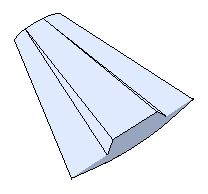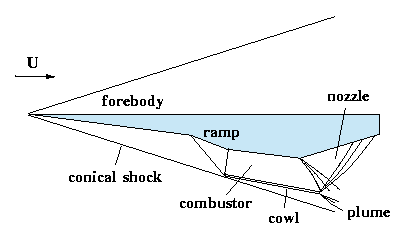

Hypersonic Waveriders
Summary
The waverider is the fastest wing of all, the wing for Mach 6 and beyond. The concept of waverider has evolved over the years. Nonwieler, 1963, devised the concept of waverider as a lifting system generated from streamlines behind a known shock wave.
Kuchemann, 1978, in his fundamental text on aircraft design saw the waverider a technical possibility by assuming a constant value of the product between propulsive efficiency and aerodynamic efficiency.
Using the Breguet range formula, Kuchemann concluded that a non-stop trans-atmospheric flight at Mach 8 to the farthest point on Earth is possible.
In light of recent research on supersonic transport vehicle, this idea seems unfeasible. However, the current interest in waverider lyes in its possible replacement of the launch systems for the space craft (new generation of spacecraft) and for Aero-Assisted Orbital Transfer Vehicles (AOTV).
 |
 |
Figure 1: Conically-derived waveriders
From a theoretical point of view a waverider is a conically-derived lifting system, that is a system that is always behind the shock wave generated by itself (Fig. 1). More practically, the waverider is a wing, an aircraft, and a propulsion system at the same time (Fig. 2) , therefore it requires a multi-disciplinary integrated design.
Preliminary studies addressed, among other issues, the aerothermodynamic heating, the thermal and structural fatigue, the aeroacoustics, the propulsion system, the type of fuel.

Figure 2: Hypersonic airplane based on waverider theory
Air-Breathing Engines
The propulsion system for hypersonic speeds is a scramjet (= supersonic combustion ram jet), that is a system without moving parts. (A recent review of scramjet technology is available in Curran-Heiser-Pratt, 1996.)
In the concept design illustrated in Fig. 2 the scramjet
is placed roughly at the center of the waverider, so that the forebody
acts as a dynamic compressor for the engine, the aft body acts as an
expansion nozzle.
From a review of existing studies: At M = 25 aerodynamic
efficiency is estimated at about 3÷4; peak skin temperatures at the nose
are of the order of 2000 K (higher in the inlet and the nozzle); acoustic
noise level at 170÷180 dB.
Lower values of the quantities reported above are
predicted for a M = 10 trans-atmospheric plane: for example the maximum
skin temperature is of the order of 1300 K.
The Lockheed SR-71A Black Bird holds at least 3
absolute records, achieved at speeds above M = 3 (among which the fastest
eastbound transatlantic flight in 1 hour and 55 minutes, 1976). No longer
flying, this aircraft reached top speeds of the order of M = 3.5. NASA's
experimental aircraft X-15 reached M = 6.7 on solid rocket propulsion in
1967. NASA's new X-43 HyperX is set to reach M = 7 and beyond on
air-breathing propulsion (with boosted launch), thus making a practical
demonstration of the viability of scramjet engines.
Most of the programs to date are focusing on
aircraft-launched systems, which would be further boosted by a rocket to
speeds high enough to ignite the scramjet (at least M = 4-5).
Another idea that is being analyzed is the intermittent
hypersonic scramjet. An aircraft with such a system would boost its speed
to M = 10 into transatmospheric flight, shut off its engines to coast back
into atmosphere and restart again for a number of times. This roller
coasting could also limit the effect of aero-thermodynamic heating.
A propulsion system that would work from rest to
hypersonic Mach numbers remains a dream not to be fulfilled for a long
time. Research programs are ongoing in many parts of the world (USA,
Europe, Australia, Japan).
These sites are not part of the aerodyn.org domain. There
is no guarantee nor control over their content and availability.
Up-to-date press releases are available from Aerospace
America, Aviation Week, and Flight International.
Performances
Where Technology Stands
Related Material
On the Web
Resources on Other Wings
Selected References
Prentice
Hall International, 3rd edition, 1998.